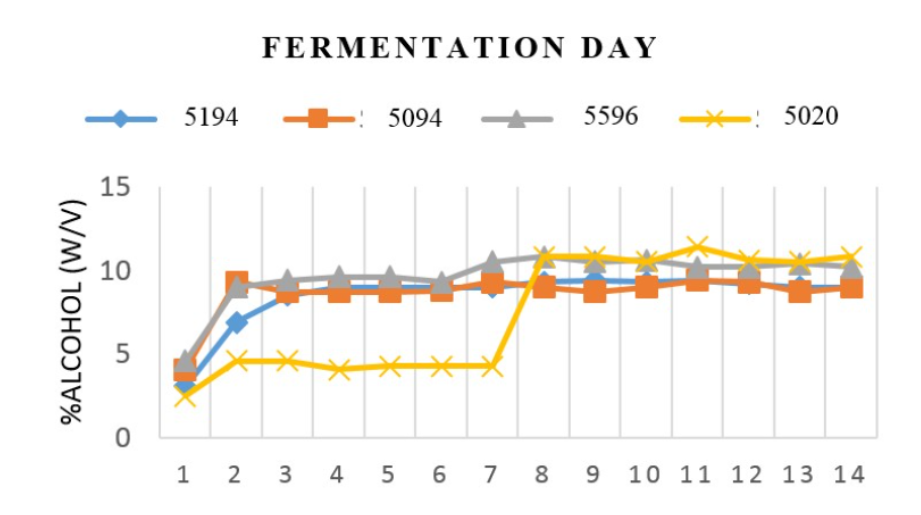The ability of various yeast strains to ferment alcohol from waste rambutan (Nephelium lappaceum Linn) fruit
Main Article Content
Abstract
Alcohol is the raw material used in the manufacture of vinegar, it can be distilled to make liquor, and refined alcohol can be used to produce ethanol as an energy source. Raw materials containing sugar, fermented with yeast, are the source of alcohol. Rambutans are fruits containing high content of sugar. After harvesting, the outside appearance of rambutans is no longer acceptable by customers because the fruit deteriorates rapidly within three to five days, resulting in decreasing value. In this research, we aimed to investigate the use of low-quality rambutans for fermentation to produce alcohol. Four single strain, two mix strains, and three combination strains of yeast (Saccharomyces cerevisiae) were used in alcohol fermentation of low-quality rambutans. The alcohol content was evaluated every day for 14 days after fermentation. The results showed that for the single strain of S. cerevisiae, the TISTR 5020 could produce the highest number of alcohol content at 11.4% after fermented 11 days, followed by the TISTR 5596 strain, which gave 10.8% alcohol on day 8. For the two mix strains of yeast, the combination between TISTR 5596 and TISTR 5194 as well as the combination between TISTR 5094 and TISTR 5596 could provide the best result at 10.5% alcohol on day 9 and day 11 respectively. In the three combinations of S. cerevisiae, the combination of TISTR 5596, TISTR 5194 and TISTR 5094 could produce 11.0% alcohol after fermented for 14 days while the mixture of TISTR 5094, TISTR 5020 and could provide 10.8% alcohol on day 4.
Article Details
References
L. C. Basso, H. V. Amorim, A. J. Oliveira, M. L. Lopes, Yeasts election for fuel ethanol production in Brazil, FEMS Yeast Re-search 8 (2008) 1155–1163.
B. Richard, Microbial fermentation, Hyper texts for biological sciences, Colorado State University, 2018.
G. W. Choi, et al., Bio ethanol production by a flocculent hybrid, CHFY0321 obtained by protoplast fusion between Saccharomyces cerevisiae and Saccharomyces bayanus, Biomass Bioenergy 34 (2010) 1232–1242.
L. Domingues, N. Lima, J. A. Teixeira, Contamination of a high-cell-density continuous bioreactor, Biotechnol Bioeng 68(2000) 584–587.
Y. H. Hui, Handbook of vegetable preservation and processing,New York: M. Dekker, 2004.
Y. L. Jin, R. A. Speers, Flocculation of Saccharomyces cerevisiae, Food Research International 31 (1998) 421–440.
D. Klein, M. Lansing, J. P. Harley, Microbiology, 6th ed., New York: McGraw-Hill, 2006.
C. Kasavi, et al., Evaluation of industrial Saccharomyces cerevisiae strains for ethanol production from biomass, Biomass &Bioenergy 45 (2012) 230–238.
N. Kosaric, J. Velikonja, Liquid and gaseous fuels from biotechnology: challenge and opportunities, FEMS Microbi-ology Reviews 16 (1995) 111–142.
L. Lin, et al., Factors affecting ethanol fermentation using Saccharomyces cerevisiae BY4742, Biomass & Bioenergy 47(2012) 395–401.
M. Mikell, Alcohol fermentation:Definition, equation& process, Available from:https://study.com/academy/lesson/alcohol-fermentation-definition-equation-process.html#/transcriptHeader, (accessed 2018).
S. I. Mussato, E. M. S. Machado, L. M. Carneiro, J. A. Teixeira, Sugar metabolism and ethanol production by different yeast strains from coffee industry wastes hydrolysates, AppliedEnergy 92 (2012) 763–768.
A. Navarro, R. M. Del, C. Sep ́ulveda, M. C. Rubio, Bio-concentration of vinasse from the alcoholic fermentation of sugar cane molasses, Waste Management 20 (2000) 581–585.
W. K. Purves, D. E. Sadava, G. H. Orians, H. C. Heller, Life,the science of biology, 7th ed., Sunderland, Mass. Sinauer Associates, 2003.
L. Stryer, W. H. Freeman and Company, (1975), Biochemistry and Biophysics Reports, 10 (2017) 52–61.
A. Tofighi, M. M. Assadi, M. H. A. Asadirad, S. Z. Karizi,Bio-ethanol production by a novel autochthonous thermotolerant yeast isolated from waste water, Journal of Environmental Health Science & Engineering 12 (2014) 107


